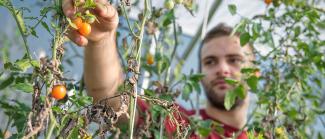
Food security, food literacy, food sovereignty, and sustainable food choices, have all been identified as key ingredients (excuse the delicious pun!) for maintaining a sustainable food system.
While creating a sustainable food system is complex and nonlinear, we all play an active role in exploring ways to create a healthier tomorrow.
Food security
Before the pandemic, it was estimated that one-in-eight Canadians were food insecure, meaning that they did not have the income to purchase enough food to follow nutrition recommendations or stave off hunger. In 2022, it is estimated that that number is around one in seven or 14% of people in Canada struggle with the ability to access food. Though the pandemic has been difficult for us all, there are risks and challenges related to food security, which have increased for many people in our community – for example, post-secondary students.
The UBC Food Hub has some terrific articles about Food Security, to help you understand this challenge.
Food sovereignty
Another important ingredient for our sustainable food system recipe is food sovereignty. This has been defined as the “right of peoples to healthy and culturally appropriate food produced through ecologically sound and sustainable methods, and their right to define their food and agriculture systems." From an Indigenous perspective, food sovereignty is not only about practicing traditional foodways but also reclaiming cultural knowledge, land governances and treaty rights, as well as the relationships between Indigenous and non-Indigenous people.
Food sovereignty is important because food systems are different for every individual and every family; it is crucial to not only have access to food options that are healthy and friendly to the environment but the food is culturally appropriate as well. We can all engage in this work by learning more about food sovereignty in our community by either researching or joining local initiatives that are working towards food sovereignty in our communities.
Sustainable food choices/ food literacy
As with health literacy, food literacy can impact our ability to advocate for ourselves and make healthy choices when it comes to how we consume food and our understanding of where our food comes from.
Simply knowing about nutritious food choices does not mean it will always result in better decision-making or better outcomes. Consulting a registered dietician is one way that you can build confidence in food decision-making. We should also try to increase our awareness of where food comes from and consider factors such as the food system, culture, and norms that influence our eating behaviours and our relationship with food.
We have more information about consulting with a dietician or nutritionist through our Employee and Family Assistance Program and through the Extended Health Plan.
What can you do?
As we explore and think about the ingredients for creating a healthier tomorrow, the task ahead and the complexity can get overwhelming; it is easy to feel that it is out of our hands. So, what can you do to create a sustainable food system?
Addressing food waste is one action we can take right away. It is estimated that the average Canadian household can waste up to 140 kilograms (about half the weight of a large motorcycle) or $1100 worth of food per year; addressing food waste can not only help to reduce our carbon footprint but also help offset the costs given the rise in food prices all around us.
This month, I invite you to explore what creating a healthier tomorrow looks like for you, it might be addressing food waste, increasing your food literacy, or advocating for food sovereignty.
Here are some helpful resources as you explore the various ingredients for a healthier tomorrow
- UBC Food hub
- Indigenous food systems
- Syilx Okanagan Nation Alliance-food sovereignty
- 5 ways to cut food waste at home
References
- Food Secure Canada. Resetting the table: A People’s food policy for Canada [Internet]. 2011. Available from: https://foodsecurecanada.org/sites/foodsecurecanada.org/files/FSC-reset…
- Nutrition Connections. Effective education strategies to increase food and nutrition knowledge in children and youth [Internet]. Toronto: Ontario Public Health Association; 2019. Available from: https://nutritionconnections.ca/resources/effective-education-strategie…
- Tarasuk V, Mitchell A. Household food insecurity in Canada, 2017-18. Toronto: Research to identify policy options to reduce food insecurity (PROOF); 2020.
- What is Food Sovereignty? Food Secure Canada. (n.d.). Accessed March 3, 2021. Available from: https://foodsecurecanada.org/who-we-are/what-food-sovereignty
Posted in Articles
Tagged
- HR
- HR Network News
- Healthy UBC